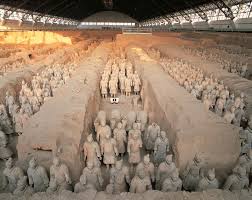
When Was the Tomb of Qin Shi Huang Discovered?
The Tomb of Qin Shi Huang, a marvel of ancient engineering and a treasure trove of historical significance, was discovered in the spring of 1974. This monumental discovery unveiled one of the largest and most intricately designed tombs in the world, captivating the imagination of archaeologists and historians alike.
The Mystery of the Unopened Tomb
Despite its discovery over four decades ago, the main tomb of Qin Shi Huang remains unopened, shrouded in mystery and speculation. Several compelling reasons contribute to this cautious approach.
The Immense Scale of the Underground Palace
The sheer size of the underground palace poses a significant challenge. Historical records, such as the writings of Sima Qian, a Han Dynasty historian, describe the tomb's grandeur in detail. Based on these accounts and preliminary explorations, archaeologists estimate the tomb complex to cover an area of approximately 50 square kilometers (20 square miles). The central tomb mound alone, where the emperor’s burial chamber is believed to be located, rises to a height of 76 meters (249 feet) and has a base circumference of 1,700 meters (5,600 feet).
A Strategic Location with Auspicious Feng Shui
The location of the tomb was strategically chosen, reflecting the importance placed on feng shui, the ancient Chinese practice of harmonizing environments. Satellite imagery reveals a striking visual: a mountain range stretching from Mount Jiao to Mount Hua resembles a colossal dragon taking flight. The tomb complex sits precisely at the "dragon's eye", a location deemed extremely auspicious in feng shui principles. This strategic placement further underscores the reverence afforded to the First Emperor and the belief in the power of geomancy.
FAQs
Q1: What is the significance of the Terracotta Army found near the tomb?
A1: The Terracotta Army, discovered just east of the tomb complex, is a vast collection of life-sized terracotta sculptures depicting soldiers, horses, and chariots. It is believed to have been created to protect Qin Shi Huang in the afterlife and serves as a testament to the emperor’s power and the artistry of the time.
Q2: Why is opening the tomb such a complex decision?
A2: There are several concerns regarding the excavation of the main tomb. Firstly, the sheer scale of the project presents logistical hurdles. Additionally, there are concerns about preserving the tomb's contents. Historical records mention the presence of traps and flowing mercury, which could pose risks to archaeologists. Finally, there is an ongoing debate about the ethical implications of disturbing the emperor's final resting place.
Q3: Are there any plans to excavate the main tomb in the future?
A3: Currently, there are no concrete plans to excavate the main tomb. Chinese authorities have adopted a cautious approach, prioritizing the preservation of the site and its artifacts. However, technological advancements in archaeology may offer safer and less invasive methods for exploration in the future.